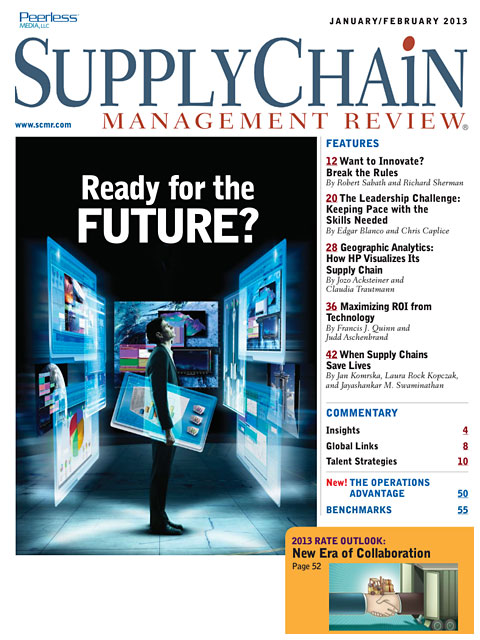Sorry, but your login has failed. Please recheck your login information and resubmit. If your subscription has expired, renew here.
January-February 2013
Supply chain management has a host of rules that most managers live by. But in certain cases, say authors Robert Sabath and Rich Sherman, true innovation comes only when those conventional rules are broken. By clearly understanding the nature of the rules and the details of your supply chain, you can know where and when rule-breaking makes sense. Browse this issue archive.Need Help? Contact customer service 847-559-7581 More options
Supply chain management (SCM) is an evolving discipline. The art and science of managing a global supply chain has gone through a transformation in response to changes in the way companies operate as well as a more complex and interdependent business environment. Practitioners need to keep abreast of these developments and adopt the appropriate mix of leadership skills.
More specifically, as the profession continues to grow beyond its physical distribution roots, supply chain managers require both broader expertise and deeper technical excellence. How to reconcile these two seemingly opposing demands is one of the most difficult leadership challenges facing SCM today.
By tracing the profession’s evolutionary track and changing profile, we can identify responses to these challenges and prepare practitioners for the leadership demands that lie ahead.
 |
This complete article is available to subscribers
only. Click on Log In Now at the top of this article for full access. Or, Start your PLUS+ subscription for instant access. |
Not ready to subscribe, but need this article?
Buy the complete article now. Only $20.00. Instant PDF Download.
Access the complete issue of Supply Chain Management Review magazine featuring
this article including every word, chart and table exactly as it appeared in the magazine.
SC
MR
Sorry, but your login has failed. Please recheck your login information and resubmit. If your subscription has expired, renew here.
January-February 2013
Supply chain management has a host of rules that most managers live by. But in certain cases, say authors Robert Sabath and Rich Sherman, true innovation comes only when those conventional rules are broken. By clearly… Browse this issue archive. Access your online digital edition. Download a PDF file of the January-February 2013 issue.
 |
Download Article PDF |
Supply chain management (SCM) is an evolving discipline. The art and science of managing a global supply chain has gone through a transformation in response to changes in the way companies operate as well as a more complex and interdependent business environment. Practitioners need to keep abreast of these developments and adopt the appropriate mix of leadership skills.
More specifically, as the profession continues to grow beyond its physical distribution roots, supply chain managers require both broader expertise and deeper technical excellence. How to reconcile these two seemingly opposing demands is one of the most difficult leadership challenges facing SCM today.
By tracing the profession’s evolutionary track and changing profile, we can identify responses to these challenges and prepare practitioners for the leadership demands that lie ahead.
 |
SUBSCRIBERS: Click here to download PDF of the full article. |
SC
MR

Latest Supply Chain News
- Tariffs, taxes and trade: The impact of Trump’s reelection on the supply chain
- How to improve demand forecasts for new product families
- Services sector sees growth in October, reports ISM
- Balanced supply chain management Part 4: The key—leading beyond the silo
- Managing inbound freight: What has changed in two decades?
- More News
Latest Podcast

 Explore
Explore
Latest Supply Chain News
- Tariffs, taxes and trade: The impact of Trump’s reelection on the supply chain
- How to improve demand forecasts for new product families
- Services sector sees growth in October, reports ISM
- Balanced supply chain management Part 4: The key—leading beyond the silo
- Managing inbound freight: What has changed in two decades?
- Inbound freight: Often a missed opportunity
- More latest news
Latest Resources

Subscribe

Supply Chain Management Review delivers the best industry content.

Editors’ Picks





